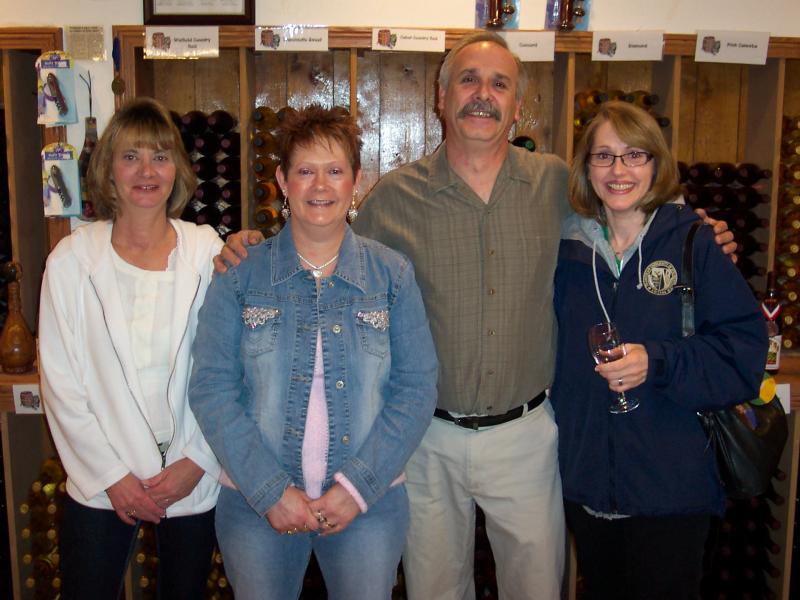Pennsylvania doesn’t spring to mind when you think of wine, and yet there are 140 wineries in the state. Equally important is that William Penn, for whom the state was named, planted the very first vinifera vines in America in 1683, and that the very first commercial vineyard in the U.S. was planted by the Pennsylvania Wine Company in 1793. Therefore, it all begins to add up.
On a recent trip to the big city of Pittsburgh I went in search of a small winery. Just outside of the Steel City the agricultural land begins to unfold. Being this was Thanksgiving, the dormant trees dotting the landscape looked like skeletons, their empty branches reaching towards a grey sky. Small brick houses dot the low rolling hills as you enter Butler County.
Heading towards the little town of Cabot, the winery, aptly named Winfield Winery, is on Winfield Road. And here’s the thing, this was a residential area and there was no commercial building, only a house fronting the road. Pulling down the driveway, fearing an angry homeowner would shout for me to get off the property, I saw the winery sign. As I greeted owner and winemaker John Ricchuito, I had the same look most people do, wondering if you’ve pulled onto private property.
“I did that on purpose in case the winery failed,” John tells me with a laugh. “I’ve got a five bedroom home with a built in wine cellar and party room!” But it appears he won’t have to worry about failure. He’s already estimating he’ll run out of space within two years and his winery is performing better than expected. Maybe it’s the 20 different wines he makes, maybe it’s the relaxed feel, or maybe it’s the award he is winning.
When his Winfield Country Red (a blend of native American grapes) won the Best American Variety Award at the Pennsylvania Farm Show his first year out of the gate, he was stunned. But it was also a vindication. “I’ve been making wine for ten years (as an amateur) and my friends were trying to make me a bootlegger, so I decided to go legit,” he jokes. “I’m full blooded Italian and I’d always wanted to make wine.”
John worked for PPG Industries (originally called Pittsburgh Plate Glass Company, a fixture in Pittsburgh since its inception in 1883) for thirty years in air conditioning maintenance. “I still have ten fingers and ten toes,” he says, a wry smile on his face. And now, after a lifetime of monitoring warm and cold, he’s getting hot with his new endeavor. He’s one of only three wineries currently operating in Cabot.
It’s easy to think of Pennsylvania and roll your eyes at the native American varieties of raspy, briar-tinged wines with too much alcohol and excessive sugar levels. Pennsylvania and the East Coast have always had to fight for respect. Either they make native varieties like Catawba, Concord and Niagara which remind most wine drinkers of sweet jug wines, or their berry wines seem great as a syrup for pancakes, but aren’t considered real wine since they are made from fruit not grapes.
Add to that the convoluted and archaic laws Pennsylvania still has on the books about wine and distribution and it’s easy to be hamstrung. For example, the state still controls all the wine stores and has a monopoly on distribution and interstate trading. But agri-tourism is a $620 million dollar industry in Pennsylvania and winemakers like John are aiding that tourism with quality wines. “My wines speak for themselves, all people have to do is try them,” he says. And it’s not just locals who stop at the tasting room to see what the goings on are. “I’ve had people visit the winery from California, Japan and South Africa,” he tells me.
In his facility, 13 feet underground, below the tasting room, he cold stabilizes his fruit at 26 degrees in a freezer he built with his own hands. The grapes, mainly from the Lake Erie area, are crushed for him, then shipped down to his winery. Though he receives initial numbers on PH levels, sugar and acid levels, John double checks the numbers at the winery and if he likes what he sees, he’ll start fermentation. Though there are native yeasts that naturally occur on the grapes, he kills them off with methyl sulfide prior to fermentation, then uses only one commercial strain of yeast.
“I don’t like to roll the dice,” he says relating to the hit and miss nature of indigenous yeasts. John allows only his dry red wines to undergo malolactic fermentation. His line-up of reds include the usual suspects: cabernet sauvignon, cabernet franc and merlot. But there’s also noiret (a red hybrid developed by Cornell University), Chambourcin and Fredonia.
The same is true with the whites. Chardonnay, pinot grigio and Reisling will make people feel comfortable with the familiarity, but then there is traminette, seyval and vignoles. And, like most east coast wineries, there are the fruit wines, which are selling fast and furious, including a white raspberry wine which he tells me he can’t keep on the shelf. He sources all his fruit locally within the county.
John would like to try his hand with California fruit one day. “I’d love to make some wine from California, red zinfandel, sangiovese, nebbiolo, barbera,” he says, in honor of his Italian heritage. But for now, the doors are open and the people keep coming. “I try and make people feel at home. People need to relax more today,” he says of the low key vibe in the tasting room. A visit to Winfield Winery will do just that.







